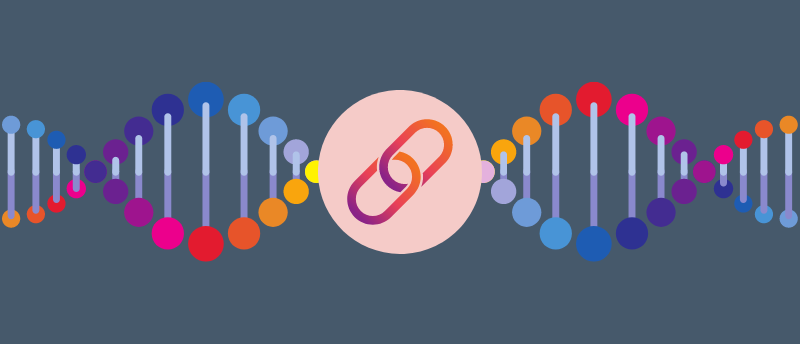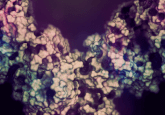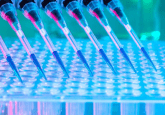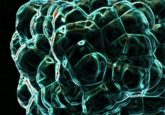Eliminating the weakest link in qPCR with Daniel Blanchard


Daniel Blanchard (left) is a molecular biologist and geneticist by training who, before joining Thermo Fisher Scientific (MA, USA), spent many years in academia, working mainly on RNA biology, RNAi and regulation of transcription and replication. Daniel has been with the company for nine years now, all in the quantitative PCR (qPCR) division, which is mostly dedicated to the development of new products.
Thermo Fisher Scientific’s commitment to innovation is exemplified by the active fostering of highly experimental, high-risk scientific projects. Much of Daniel’s work at the company has involved these types of ventures, which, if successful, can then become products (TaqPathTM BactoPureTM master mix constituting a case-in-point). To do so, projects must be developed by teams with diverse expertise, and one aspect of Daniel’s job entails coordinating these groups’ efforts to build effective products.
What is the TaqPath BactoPure microbial detection master mix and how does it work?
BactoPure microbial detection master mix is a reagent that contains the chemical components required for a successful, reproducible and highly sensitive qPCR reaction, wherein the user needs only to add a TaqMan® assay of choice and DNA sample to complete the experimental setup. It has been developed to provide consistent and reliable results, even in the presence of inhibitors commonly found in typical qPCR samples such as soil, human bodily fluids and tissue cultures. The most salient feature of BactoPure master mix is that it has been thoroughly decontaminated of any spurious nucleic acids, and each lot is rigorously tested before release to help ensure it is virtually free of detectable DNA background. This latter attribute, in combination with high sensitivity (down to the mathematical limit of detection) and wide dynamic range, makes it ideal for detection from single copy to very high levels of microbial (or general) DNA present in a sample.
Why is a tool like this necessary for qPCR?
BactoPure master mix’s negligible nucleic acids background is essential for a myriad of qPCR applications involving the detection of low levels of DNA using broad phylogenetic coverage qPCR pan-microbial assays, as even trace reagent contamination would otherwise confound the signal. This type of qPCR testing is particularly useful for monitoring bioburden or low abundance pathogen contamination in mediums like potable water, food and biopharmaceutical bioactive compounds, just to name a few.
How can it be used in molecular diagnostics and biopharmaceutical research?
Molecular diagnostics typically involves the detection of low-abundance unknown infectious agents in complex sample matrices, such as blood, sputum and other human samples; BactoPure master mix’s high inhibitor tolerance, sensitivity and low DNA background are very well suited for this type of testing.
Since biopharmaceuticals involve the generation of bioactive molecules intended for use in humans, it is a regulatory requirement that the therapeutic dose be free of adventitious microbial content, which is commonly present in very low abundance. BactoPure master mix, in combination with the appropriate pan-microbial assays, was specifically designed as a tool to test for such contamination. Moreover, its extensive dynamic range allows for the detection of a wide span of concentrations of transgenes, human DNA and other sequences of interest at each step of many standard biopharma workflows where DNA concentrations tend to vary greatly.
What are some of the advantages of using this master mix?
BactoPure master mix’s sensitivity combined with the fact that it is free of detectable spurious nucleic acids allows for single-copy DNA detection using broad coverage assays (16S rRNA pan-bacterial, 18S rRNA pan-eukaryotic, etc.). Its high inhibitor tolerance is compatible with minimally processed samples (e.g., untreated tissue culture media), and the rigorous lot-to-lot quality control helps ensure reproducibility. Moreover, its broad dynamic range allows the detection of a breadth of DNA concentrations. Finally, BactoPure master mix comes in two formulations, with and without ROX as a passive reference dye, enabling higher order multiplexing to increase analytical capabilities while reducing costs.
What are some of the common questions your customers ask and how do you address them?
Early in product development, we realized that proper use of BactoPure master mix would require a paradigm shift regarding qPCR workflows. Standard practice is to keep reagents, plastics and consumables in a common lab, setting up qPCR reactions atop the lab bench. These conditions are far from sterile, which, while irrelevant for most qPCR applications, is incompatible with low-level pan-microbial detection due to high stochastic background resulting from ubiquitous environmental nucleic acid contamination. To attain the required sterile working conditions, we began by setting up reactions in decontaminated qPCR hoods followed by the exclusive use of sterile and decontaminated reagents and consumables. Ultimately, we realized the necessity of implementing individualized procedures to decontaminate specific reagents. All of the resulting sterility-related protocols are contained in an extensive BactoPure master mix user guide.
Consequently, the main questions we get from customers relate to the maintenance of sterile workflows. Many users, particularly those with extensive qPCR experience, often fail to follow the pertinent recommendations within our user guide, resulting in unsatisfactory results, particularly when broad phylogenetic coverage assays are involved.
We are also frequently asked about the assays used in our standard quality-control protocol, designed to ensure that BactoPure master mix is free of measurable DNA contamination. A significant amount of work was invested in establishing a reliable panel of broad-coverage assays to test for the most prevalent sources of contamination. To this end, we developed a set of 10 assays targeting pan-bacterial, pan-mammalian, pan-vertebrate, pan-fungal and common antibiotic resistance sequences, which are detailed in the certificates of analysis of each BactoPure master mix lot and orderable from the Thermo Fisher website.
Do you have any top tips for using the TaqPath BactoPure microbial detection master mix in biopharmaceutical research?
I would strongly recommend reading and following the user guide as closely as possible, especially when working with pan-microbial assays. It seems particularly useful to labor under the premise that ‘the chain is as strong as its weakest link’, meaning the qPCR reactions will be as clean as the most contaminated component used. Assume that any element not indicated as ‘sterile’ or ‘DNA-free’ is likely contaminated, clean it up if possible or replace it if necessary, and take every precaution to avoid nucleic acid contamination.
The products mentioned on this page are for Research & Laboratory use only!
This interview was sponsored by Thermo Fisher Scientific.






